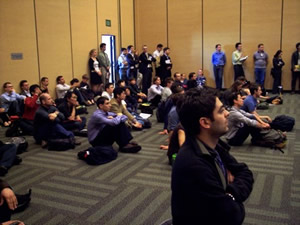Monday, April 20th, 2009
The Materials Research Society (MRS) Spring Meeting in San Francisco is so huge, this year attracting a record of over 5,000 attendees, that strategy is needed to try to see any representative sample of the event. To provide in-depth information about new materials technologies, new symposia have been added over the years such that there are now 41 sessions comprised of over 4,000 oral and poster presentations. Sipping from a firehose was never more refreshing, as can be done with online abstracts.

Standing room only in one of the presentations in Symposium R “Materials for Renewable Energy at the Society and Technology Nexus” of the 2009 Materials Research Society spring meeting (source: MRS)
For the electronic materials technologies that were the foundation of Silicon Valley, there were excellent updates on everything from high-k metal-gate (HKMG) transistors, to new 3D packaging materials, to thin-film transistors (TFT) for LCD, to non-volatile memory (NVM) cell technologies. The top electronics researchers in the world presented their most recent data to audiences of just 20-30 people, while around the corner it was standing-room only for talks regarding energy (see figure), the environment, or medicine.
Energy and the environment are clearly the main areas of interest these days. With 92 non-radioactive elements in the period table from which to draw, there are nearly endless combinations of compounds and nano-structures to test for new properties. Photoelectrochemistry may be used to generate hydrogen from sunlight and water. Shape-memory polymers may create artificial muscles. Any change of state in matter may be conceived of as the basis for a new IC memory cell.
IBM updated on porous low-k (PLK) dielectrics, H-P Labs updated on ReRAM (a.k.a. “memristors”), and RHEM and Ovonics updated on chemical-vapor deposition (CVD) of phase-change memory (PCM) materials. Both of the 2007 Nobel Laureates in Physics, Fert and Gruenberg for the giant magnetoresistive (GMR) effect used in hard-disk drives (HDD), presented as part of the symposium on spintronics. Details on these and other new electronic materials developments will be in upcoming BetaSights Newsletters. –E.K.
Tags: 32nm, 3D, CMOS, FPD, high-k, HKMG, IC, low-k, materials, memory, MEMS, NVM, PV, R&D, Si
